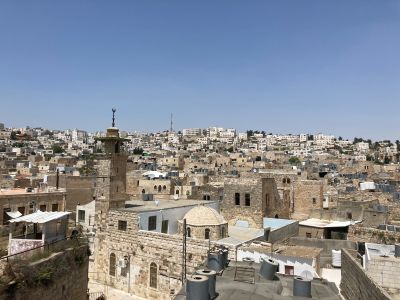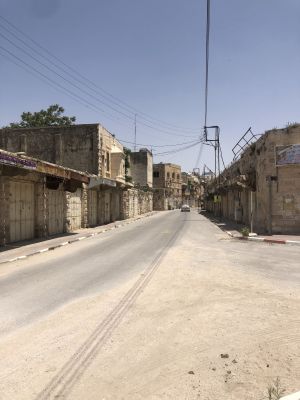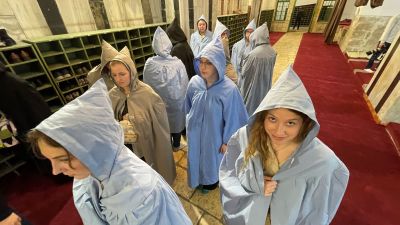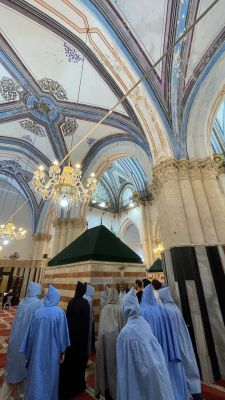“The Silent Street of Hebron”
Ana Neufeld Weaver
One unexpected reality of the Israeli occupation of Palestine is that explicit violence is not a constant reality. Instead, it is sporadic and inconsistent. The daily realities of living under occupation are subtle, yet still devastating. A tourist walking around Bethlehem could easily be unaware of the occupation. The streets are lively and there are no soldiers in sight. It is not until you see the Wall and the checkpoints that you are aware that anything is amiss. However, if you take the time to talk to local Palestinians and learn about their history, you will be able to see the signs everywhere you go. You’ll notice that those buildings in front of you are a refugee camp, that the hill in the distance is covered with an Israeli settlement, or that this piece of flat land with invasive trees is the sight of a destroyed Palestinian village. These hidden signs were a constant around Palestine, but every once in a while, there were more blatant signs of the occupation.
About a week after we arrived in Palestine, we went to Hebron. The reality of the occupation in Hebron is very different from the reality in Bethlehem. There I experienced the severity of the occupation for the first time. Our day in Hebron began under the watchful eye of Israeli soldiers. We stood talking to a young adult from Hebron across the street from a guard tower. He was telling us about some of the challenges of living in the city and the ways that soldiers mistreat inhabitants. It is likely that one of the soldiers heard everything that the young man was telling us, yet he continued to talk to us without hesitation. From there, we walked through old city Hebron, past vendors desperate for business. Each one called out to us to stop, as we were some of the only tourists in the city. We had been told not to stop, but it was heartbreaking to push past them without acknowledging their pleas for us to look at their wares.
Eventually, we arrived at the Abrahamic Mosque and Synagogue (or the Cave of the Patriarchs/Ibrahimi Mosque), in which Abraham and Sarah are buried. Originally a mosque, the building was split in half to create a synagogue and mosque after Muslims were massacred by a Jewish American settler inside. We were all allowed to enter the mosque after putting on head coverings, but we were stopped when we tried to enter the synagogue. A young female soldier asked us who we were and where we were from. After hearing that we were Christian students from the United States she allowed us to go, but she stopped the Palestinian guide who was leading us. When our guide said that he was from Bethlehem, the soldier told him that he was not allowed to go into the synagogue. He was not even allowed to use the porta-potty outside of the synagogue. Those blatant signs of discrimination were really difficult to witness. We had heard about how Palestinians were turned away at checkpoints, but seeing it happen in front of me helped me understand the extreme discrimination that Palestinians face. We reunited with our guide in a Palestinian-owned shop that was right in front of the checkpoints. The vendors there told us about their experience with the occupation. They had been offered endless amounts of money by the Israeli army to move their storefront, but they refused to move. I was amazed by the vendors’ strength to resist the Israeli’s proposals for the sake of protesting the occupation.
From there, we entered Emek Hebron Street (also Shuhada Street, King David Street, or called Apartheid Street by local Palestinians). A soldier checked all of our passports before he allowed us to enter. The group tentatively moved into the empty street that is used as a buffer zone to “protect” the Israeli settlement inside the city. As we walked through the empty street, I was crushed by the silence. The atmosphere was void of life. Every once in a while, we would pass people in a car or see a soldier watching us from afar, but otherwise we were alone in the silent street. Up until this point, I had felt safe in Palestine and Israel, but in that moment I was afraid. The street was a symbol of the depopulation and destruction of Palestinian homes that has been happening since 1948. Our guide told us that this used to be the biggest market street in Hebron, with bustling market booths lining the streets. Now, the people who still lived on that street were not even allowed to go out onto their balconies. Finally, we reached a section of the street where there was some life. Two young boys were riding bikes down the street in front of their homes. On one hand, it was encouraging to see their vibrancy in the midst of the desolate street, but it was also heartbreaking to realize that this is their daily life.
Oddly enough, we were not the only foreigners on the street. We passed a group of UN representatives who were talking to some of the families that lived on the street. This could be a hopeful sight and one might think that the UN representatives would help to change the situations of the Palestinians living there. Sadly, all the Palestinians we talked to seemed to believe that those representatives and the UN could do nothing to help their situation.
Soon after seeing the UN delegation, we reached the checkpoint and exited the buffer zone. The moment we exited the checkpoint, the world roared back to life. We entered a busy market street where we were swept back into a crowd of people. I instantly relaxed as the deafening silence was replaced by the raucous sounds of daily life. We continued down the street, passing food stands, vegetable and fruit vendors, clothing vendors, and many more. Our guide stopped at a produce stand to buy us fruit. The vendor looked at us, welcomed us to Hebron, and gave us a free case of strawberries. Just a street away from the buffer zone where I had felt afraid and isolated, I felt safe and welcomed in Hebron by this Palestinian man.
Although the occupation is not as blatantly visible in all of Israel and Palestine as it was in Hebron, the Emek Hebron Street represents the reality of the occupation for Palestinians. The Israeli occupation has stripped many Palestinians of their land, extinguished the lives of people and cities, and left desolation where there once was vibrant life. Yet in the face of discrimination and oppression, the children still ride their bikes down the silent streets, and the Palestinians still live life fully and authentically.









